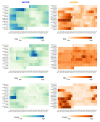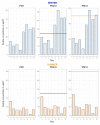Harmonization and Visualization of Data from a Transnational Multi-Sensor Personal Exposure Campaign
- PMID: 34770131
- PMCID: PMC8583633
- DOI: 10.3390/ijerph182111614
Harmonization and Visualization of Data from a Transnational Multi-Sensor Personal Exposure Campaign
Abstract
Use of a multi-sensor approach can provide citizens with holistic insights into the air quality of their immediate surroundings and their personal exposure to urban stressors. Our work, as part of the ICARUS H2020 project, which included over 600 participants from seven European cities, discusses the data fusion and harmonization of a diverse set of multi-sensor data streams to provide a comprehensive and understandable report for participants. Harmonizing the data streams identified issues with the sensor devices and protocols, such as non-uniform timestamps, data gaps, difficult data retrieval from commercial devices, and coarse activity data logging. Our process of data fusion and harmonization allowed us to automate visualizations and reports, and consequently provide each participant with a detailed individualized report. Results showed that a key solution was to streamline the code and speed up the process, which necessitated certain compromises in visualizing the data. A thought-out process of data fusion and harmonization of a diverse set of multi-sensor data streams considerably improved the quality and quantity of distilled data that a research participant received. Though automation considerably accelerated the production of the reports, manual and structured double checks are strongly recommended.
Keywords: air quality; data fusion; data treatment; data visualization; exposure assessment; multi-sensor; participant reports.
Conflict of interest statement
The authors declare no conflict of interest.
Figures








References
-
- Wellenius G.A., Schwartz J., Mittleman M.A. Health and the environment: Addressing the health impact of air pollution: Draft resolution proposed by the delegations of Albania, Chile, Colombia, France, Germany, Monaco, Norway, Panama, Sweden, Switzerland, Ukraine, United States of America, Uruguay and Zambia. Sixty-Eighth World Health Assembly. 2015;14:68.
-
- Payne-Sturges D.C., Marty M.A., Perera F., Miller M.D., Swanson M., Ellickson K., Cory-Slechta D.A., Ritz B., Balmes J., Anderko L., et al. Healthy Air, Healthy Brains: Advancing Air Pollution Policy to Protect Children’s Health. Am. J. Public Health. 2019;109:550–554. doi: 10.2105/AJPH.2018.304902. - DOI - PMC - PubMed
-
- Jerrett M., Donaire-Gonzalez D., Popoola O., Jones R., Cohen R.C., Almanza E., de Nazelle A., Mead I., Carrasco-Turigas G., Cole-Hunter T., et al. Validating novel air pollution sensors to improve exposure estimates for epidemiological analyses and citizen science. Environ. Res. 2017;158:286–294. doi: 10.1016/j.envres.2017.04.023. - DOI - PubMed
Publication types
MeSH terms
LinkOut - more resources
Full Text Sources
Medical

